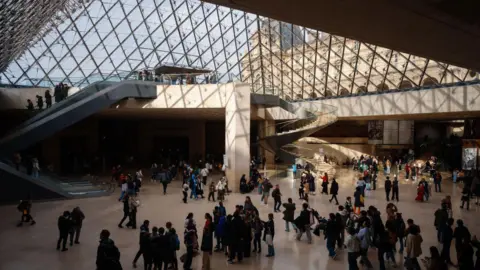From - BBC world News
By - Hugh Schofield - BBC News, Paris
Edited by - Amal Udawatta

The Mona Lisa will be moved to a new exhibition space at the Louvre in Paris as part of a plan to renovate the world's most frequented museum.
Emmanuel Macron stood in front of the masterpiece by Leonardo da Vinci as he made the announcement to an audience of dignitaries, with the change to be introduced by 2031 and visitors charged separately to see the painting.
The French president was outlining his New Renaissance project, which will also involve an international competition to design a second entrance to relieve the growing pressure of visitor numbers beneath the famous glass Pyramid.
Tariff changes will also be introduced from next January so non-EU residents - including UK tourists - pay more to visit.
 Getty Images
Getty ImagesMacron was giving his response to warnings from the Louvre's director Laurence des Cars that the museum was suffering from grave problems of overcrowding and failing infrastructure.
In a letter to the government made public earlier this month, Ms des Cars said the pyramid - which since 1989 has housed the unique access point to the galleries - was "structurally unable to cope" with visitor numbers that now reach more than nine million a year.
She also said that "in the view of everyone, the presentation of the Mona Lisa... is something that needs to be looked at".
About three-quarters of the museum's 30,000 daily visitors go to see Leonardo da Vinci's painting, but the experience has become an endurance test, with a constant crowd being funnelled through the Salle des Etats and getting on average 50 seconds to observe the picture and take photos.
"The public... has no way of comprehending the artist's work, which raises questions over our whole mission of public service," Ms des Cars said in her letter.
Under Macron's project, the eastern facade of the museum - which consists today of a classical colonnade fronted by an artificial moat and a little-used esplanade - will be redesigned.
A new entrance-way will give immediate access to new underground exhibition spaces beneath the Cour Carré, which will in turn connect with the area beneath the pyramid.
Macron said the new front - the biggest change to the museum since President François Mitterrand's Grand Louvre project 40 years ago - would tie in with city plans to create a tree-filled "green" zone on the esplanade.
It would, he said, help integrate the museum into the city and "give it back to the Parisians".
He added that removing the Mona Lisa from its current position would allow the museum to present it properly, and make it easier to view other masterpieces, which are "too often overlooked", on display in the Salle des Etats.
Major renovation work will also be undertaken in the coming years to modernise infrastructure, and provide new toilet, restaurant and rest facilities.
The overall cost is put at several hundred million euros.
Macron said the project would cost the taxpayer nothing, as it would be funded through ticket sales, donations, and the museum's sponsorship deal with the Louvre Abu Dhabi.
His powers significantly curtailed since losing control of the French parliament six months ago, the president has been in search of a new cause with which to assure his legacy.
His much-praised leadership in the post-fire renovation of Notre-Dame cathedral appears to have whetted his appetite for a similar grand projet at the Louvre.
Comments
Post a Comment